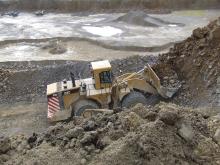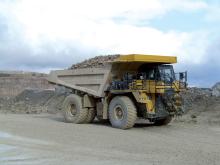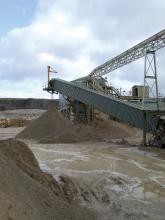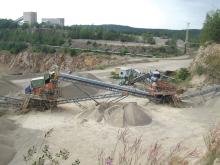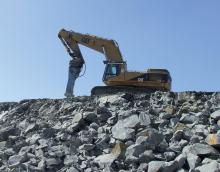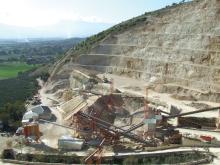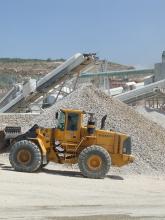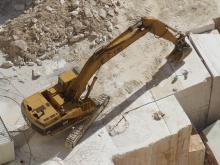
High in the French Pyrenees lays the world's largest talc quarry. Claire Symes visited Rio Tinto Minerals' Trimouns quarry to find out more
Mention talc, and most people would think of talcum powder but the soft mineral is actually essential to the manufacture of a huge number of items used on a daily basis. Many plastics, paints, foods, medicines, cosmetics, ceramics and paper, to name just a few products, all have talc as a central ingredient - but where does it come from? For over 100 years a significant proportion of the talc used in Europe has been extracted from a quarry high above the valley-floor village of Luzenac in the south of France. Each year the mountain-top quarry, which is owned by Rio Tinto Minerals, shifts 3.5million tonnes of overburden to extract around 400,000tonnes of talc.
Talc from Luzenac used to be a global product but, according to Rio Tinto Minerals Luzenac general manager Alexander Kristen, the material is not shipped as far these days due to rising fuel costs. "The value of the talc on the open market is dependent on the purity. Only around 10% of the production volume is super white, which can command a price of up to €800 per tonne but lower grades may only sell for €150 per tonne," he said.
"The way material is processed has changed with demand from the industries that use the talc - in recent years there has been a trend towards using finer grinds but producing material in this way is very labour intensive," said Kristen. "In the 1970s it was the demand from the paper industry that shaped the talc market but now it is the demand for polymers that has a bigger influence.
The market for polymers is likely to continue growing too - modern cars often contain 15 different types of polymer." The talc deposit at Luzenac is the result of metamorphic alteration at the boundary between a high chlorite mica schist in the footwall and doleritic marble in the hanging wall.
The material was formed under alteration by hydrated magnesium silicate with the higher talc concentration occurring towards the hanging wall. The dip of the deposit varies from 20 to 60º and strikes from north to south which influences the layout of the quarry.
Accessing the deposit
Overburden at the site is drilled and blasted to expose the talc ore and the stripping ratio is around 8:1 at the Luzenac quarry. Blasting is carried out daily with drilling and loading of the 165mm diameter drill holes with ANFO the responsibility of an Italian sub-contractor.
"Blast holes are positioned with a burden of 5.4m and a spacing of 7m to create the 15m high benches," said Rio Tinto Minerals Luzenac production manager Julien Conté. "The contractor uses non-electric detonators with a 25ms delay between holes, and a 42ms delay between rows. Usually 20 holes are loaded for each blast using 3tonnes of explosives." The blasted material is then loaded into rigid dump trucks for transfer to the crusher and the material is then used to maintain the haul roads within the quarry. Excess material is used to backfill and restore worked out areas of the quarry.
The talc itself is extracted mechanically by a fleet of 900 series
"Until the 1980s, the talc was dug out and sorted by hand," explained Conté. "Then the works force was much higher than it is today and was up to 300 at one point but today is about half of that."
When the talc was all sorted by hand, Luzenac used to make any new managers joining the company work on sorting in the quarry for a day to ensure they understood the business from the quarry floor upwards.
The operators use a 0.8m3 bucket to selectively extract the talc and place it into four piles depending on the grade. From there the stock piles are loaded into an ADT for transport to the storage yard.
"We have to lay concrete slabs over the talc so that the ADT can traffic over it as it is very soft, particularly when we have had heavy rain. In dry weather the dust from the talc can also be a problem and then we have to spray water on a regular basis," explained Conté.
"We also have to be careful about how the talc is handled as some of it ends up in the food industry, so the site is dotted with mobile toilets for the workers." Close to the boundary where the talc body meets the doleritic marble, the talc is more consolidated and requires blasting to extract it. Here Luzenac uses a
Once the different classes of material have been transported to the storage yard within the quarry, a sample tube mounted on the back of a backhoe loader is used to take material for analysis. The in-quarry laboratory checks the whiteness of the material as well as the chemical composition in terms of the percentage of talc, chlorite and carbonate in each sample.
"All of the trucks are fitted with GPS so we can trace where each stockpile was taken from," said Conté. "We have a bespoke designed program called Logimine to monitor and record the movements of material around the site. Having this kind of historical detail is very useful." Once the classification is confirmed, the rest of the material in the stock piles is then passed through a Nordberg jaw crusher.
Cable car solution
Transporting material down to the processing plant on the valley floor within the village of Luzenac from the quarry is what makes the operation unusual - the site has a cable car system for the purpose.
Roads leading up to the site are just not suitable for regular trafficking by the quarry's rigid or articulated dump trucks. Recent delivery of the new
Instead the cable way carries material in 1.4tonne capacity buckets from the sorting yard and down the 5km long route to the processing plant 1.1km below, saving the 16km journey by road.
The existing system was installed in the 1970s but was very forward-thinking for its time - it features a dynamo that helps to provide around 80% of the power needed for the quarry.
"Material is delivered direct from the crusher via a conveyor and two chutes transfer the material into the cable car buckets," said Conté. "The operation of the system is very weather dependant - if the wind speed reaches 11metres per second, then the cable way has to be stopped. There is a warning alarm which triggers if the wind speed goes above 9metres per second. At the start of the season in April, wind and rain can cause ice to form on the cable way and in the height of summer, we frequently close the system down in the afternoon to avoid any problems with lightning strikes from the thunderstorms that are common at that time of year due to the heat. The shutdown also gives us time to carry out maintenance on the electrical braking system."
Sorting
Around 340,000tonnes of the material extracted undergoes processing at the plant with around 40% being put through the optical sorter to separate the whiter, purer grades of talc. The remaining 60,000tonnes of the quarry's output is shipped to Luzenac's other processing plant in Ghent, Belgium or sold directly to ceramics manufacturers which use their own refining processes.
The man with the plan
Planning the quarry and managing the extraction is the responsibility of production manager Julien Conté who studied geotechnical engineering at the Ecole Nationale Supérieure de Geologie de Nancy. Before joining Rio Tinto Minerals as Luzenac's geologist, Conté worked in a gold mine in the Ivory Coast.
"I have been interested in geology for a long time but didn't want to be an exploration geologist, which was why I studied engineering geology," he said. "I was more interested in extraction technology. Working in a gold mine was very different to the talc operation but was a good experience." Conté moved back to his native France in 2005 to join Luzenac and was later promoted to deputy manager before taking on the manager's role at the start of this year.
"My engineering geology skills are not being wasted though," he said. "They have come in very useful for helping to understand and resolve the instability problems in the footwall." It is Conté's responsibility to work with the company's sales forecasting department to plan how to open up the talc deposit to best meet the predicted demand for that year, as well as looking ahead to subsequent years of operation at the site.Material that is put through the optical sorter is washed and then screened before being analysed.
"Around 140,000tonnes of talc is put through the optical sorter each year in order to extract 40,000tonnes of white products," said Rio Tinto Minerals Luzenac sorting plant manager Lilian Fernandez. "The market for talc calls for about 90% grey and 10% white but the ore body at Luzenac naturally delivers 95% grey and 5% white, so optical sorting is essential to make the most of the white material that is extracted." The sorter uses four 80W neon lights linked to a numeric camera to monitor the whiteness of particles passing through. Software linked to this operates an air jet to direct the particles according to their whiteness.
"The system can process between 500 and 300 particles per second. Output is dependent on the granulisation but varies between 5 and 40tonnes per hour," said Fernandez. "White particle recovery is around 70 to 90%."
After sorting, the talc is then dried in a long tubular oven at a low temperature - less than 1000C - to lower the moisture content but prevent carbonisation. Material can then be stored in one of the site's 18 dry silos depending on the grade of material before being ground for the specific end market.
To obtain just the right particle size distribution curve and top cut for a given application, the techniques used include compressed air, steam and impact grinding. Median particle sizes can range from less than 1micron to 15microns, and top cuts from 6microns to over 100microns.
The grinding plant has 17 roller mills with a dynamic classifier to process talc for most markets, such as agriculture and cosmetics. But the polymer and paints markets require a finer product - less than 45microns - and this is processed using micronisation.
"Micronisation is only carried out for specific orders for speciality products because it is very energy intensive," said Kristen. "Processing in this way accounts for 25% of our talc production, but calls for about 50% of the energy consumption." Processed material is then shipped to customers either in bags or by rail, ship or road as a dry powered bulk product or sometimes as pellets for the polymer market.
Safety
Like all quarries, Luzenac is very safety conscious but unfortunately the company's good record was broken earlier this year when someone working at the quarry suffered a fatality.
Drill
1x Sandvik Ranger 600
RDTS
2x Cat 777
4x Komatsu 985HD
Drill
1x Sandvik Ranger 600
Excavators
4x Liebherr 900
1x Liebherr 922
1x Liebherr 924
2x Liebherr 934
1x Liebherr 944
1x Liebherr 994B
Wheeled Loaders
1x Cat 992G
Static Crusher
1x Nordberg jaw crusher
"The accident happened in February during the quarry shut down," said Conté. "A driver was taking a truck down the mountain road for maintenance but the truck overturned and he was sadly killed by the accident. Investigations have found no mechanical reason for the accident and have suggested human error as the possible cause. Although we have had two minor accidents this year, the last death in the quarry was 26 years ago." Safety is a key part of the culture within the Rio Tinto Minerals group and any meeting within the business starts with what Conté calls 'safety share'. "It involves anyone at the meeting raising an issue about an accident they've seen or a potential problem to make others aware of the danger," he said. "At the last meeting our waste supervisor said that he was working near the footwall and saw a snake, so as a result he warned others to be vigilant about vipers and adders on the site. Although safety features at every meeting, we also have dedicated safety meetings.
"For the workers on site that may not be in those meetings we have a two week theme running to focus on a particular aspect of safety - at the moment the theme is noise and dust and is aimed at ensuring people have the right personal protective equipment. The next theme will be change management needed when using a new technique or piece of equipment." Luzenac also continually promotes its 'Take Five' campaign which encourages anyone undertaking a task that is outside their normal operations to follow a check list and consider five questions and take five minutes to consider the risks involved.
Green focus
Although 80% of the power needs at the quarry are met by the dynamo on the cable way, a further 10 to 15% of the power is delivered from three hydro-electric plants around the site.
The quarry has two balancing ponds which collect snow melt water and rainfall from the site. "The talc is impermeable so the wash off from the site usually contains a suspension of talc," explained Conté. "The ponds allow the talc to settle before the water flows into one of the three rivers in the area. We have also set up several ponds for animals at the request of landowners." Landowners are also influencing the design of the restored parts of the quarry. Older parts are restored as meadows but more recent backfilling is stepped and was being planted with trees. "Local farmers asked us not to plant the trees and just grass the banks so that they had extra grazing land available to them," said Conté.
"Some of the older waste dumps will have to be moved in the future as they are restricting access to the ore body."
Future expansion
In a bid to maximise the production of the bright talc, there is a plan underway to install a new hi-tech optical sorting plant within the quarry to carry out sorting before material reaches the cable way. "At the moment there is a bottleneck after the cable way and moving the plant will remove it and give more room at the site in the village," said Conté. "Moving the plant will also remove some issues with noise and dust, which are currently being overcome using broadband sound and water sprays." Although ownership of Luzenac is likely to change in the near future as Rio Tinto looks to re-focus on its core mining operations, the quarry has proven reserves for around another 20 years and possible reserves that could last up to 60 years. "The extent of the reserves is dependant on the price of talc in the open market," said Kristen. "If the price remains high, then the quarry will remain economical as extraction goes deeper."
Seasonal operation
Although the quarry is a hive of activity in the summer months, it is not always this busy. The altitude of the quarry at between 1600 and 1800m above sea level means that weather has a significant impact on production. "Fog causes more problems for us than rain - when our largest rigid trucks are fully laden they can weigh up to 105tonnes so the rain slows the cycle time," explained Rio Tinto Minerals Luzenac production manager Julien Conté. "But heavy snow during the winter months means extraction has to stop between November and April as the conditions are too difficult to continue working under.
During this period, equipment is moved to the in-house workshop to undergo major maintenance. "During the summer the workshop tries to focus on curative maintenance to keep production at the optimum level and then any major problems can be sorted out during the winter shut down," said Conté.
But while extraction stops, the processing plant down in the village continues working and uses the 250,000tonnes of talc stored on site to make sure there is a steady flow of material into the market.
"It is always a challenge to ensure we extract the right amount of talc during the operational period to meet current demand and demand during the shut-down period," said Conté. "We produce 14 different grades of talc and it is essential that we have enough stocks of each to meet demand - having accurate sales forecasts is very important for the production planning."
The quarry operates five days a week, with a 17 hour day split between two shifts. "During the extraction period, the quarry employs around 150 people but half of them are seasonal workers who travel from abroad to work here each year and live on site at the quarry," said Conté. "In the winter months, some of the seasonal workers are employed by nearby ski resorts as guides and instructors." Down in the valley, at Luzenac processing plant, another 165 people work at the plant or providing support services to the quarry.
Talc heritage
Luzenac Talc first started working the Trimouns - which means three peaks - Quarry in 1905 but the history of talc extraction in the region goes back much further.
Extraction of talc from the Luzenac area dates back to at least 14,000 years ago and has been proven through analysis of paint used in cave paintings found in the area. Later followers of the Cathar religion in France between the 11th and 13th Century used the talc to make sculptures.
Nonetheless, it wasn't until much later that other uses of talc were discovered - apothecaries used local flour mills to grind talc for cosmetics and medicines in the 1850.
When Trimouns first started extracting the material, annual production was around 20,000tonnes and was delivered to the valley floor by a cable car system even then. By the 1950s production had grown to 100,000tonnes and the third generation of cable cars were installed in the 1960s.
"Before the 1970s talc was used as a filler material in many processes and was not the premium product it is today," said Rio Tinto Minerals Luzenac general manager Alexander Kristen. "Today the company re-invests around 3% of its turnover into research and development and tries to recruit from the industry it supplies in order to gain more end product knowledge. It is this kind of investment that has led to production of high aspect ratio (HAR) talcs for plastics." The company was acquired by Rio Tinto in 1988 and forms part of the Minerals Group and this has brought both investment and development. However, Rio Tinto has announced that is plans to re-organise its structure and focus on its core area of mining so is currently looking to divest Luzenac and its Borates business from its portfolio.
Tourists visiting the area can also find out about the operation as the company runs daily tours of the site with guides to explain the operation. These visitors do not actually enter the quarry but are taken by bus to a vantage point above the working area to get a clear view.


